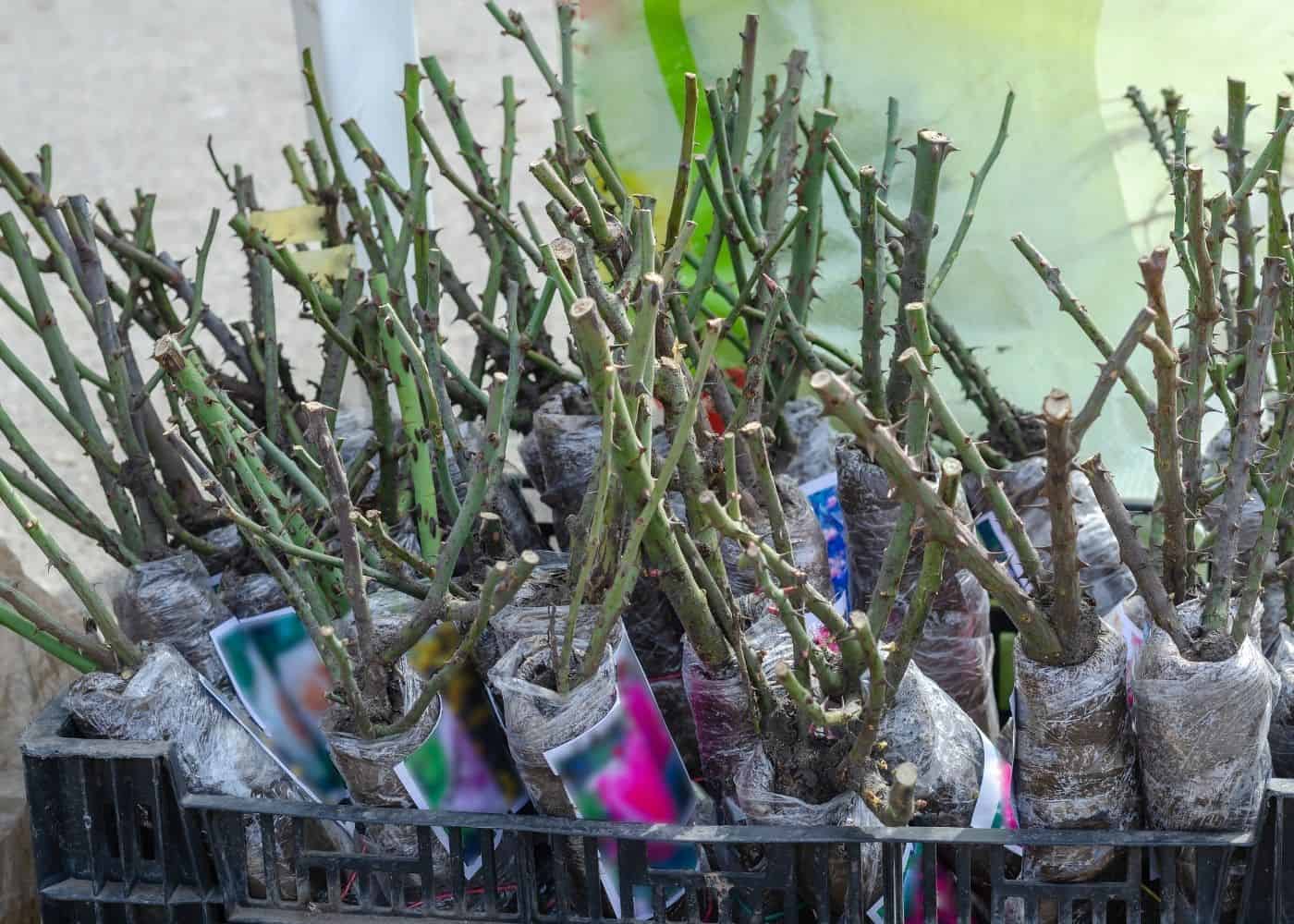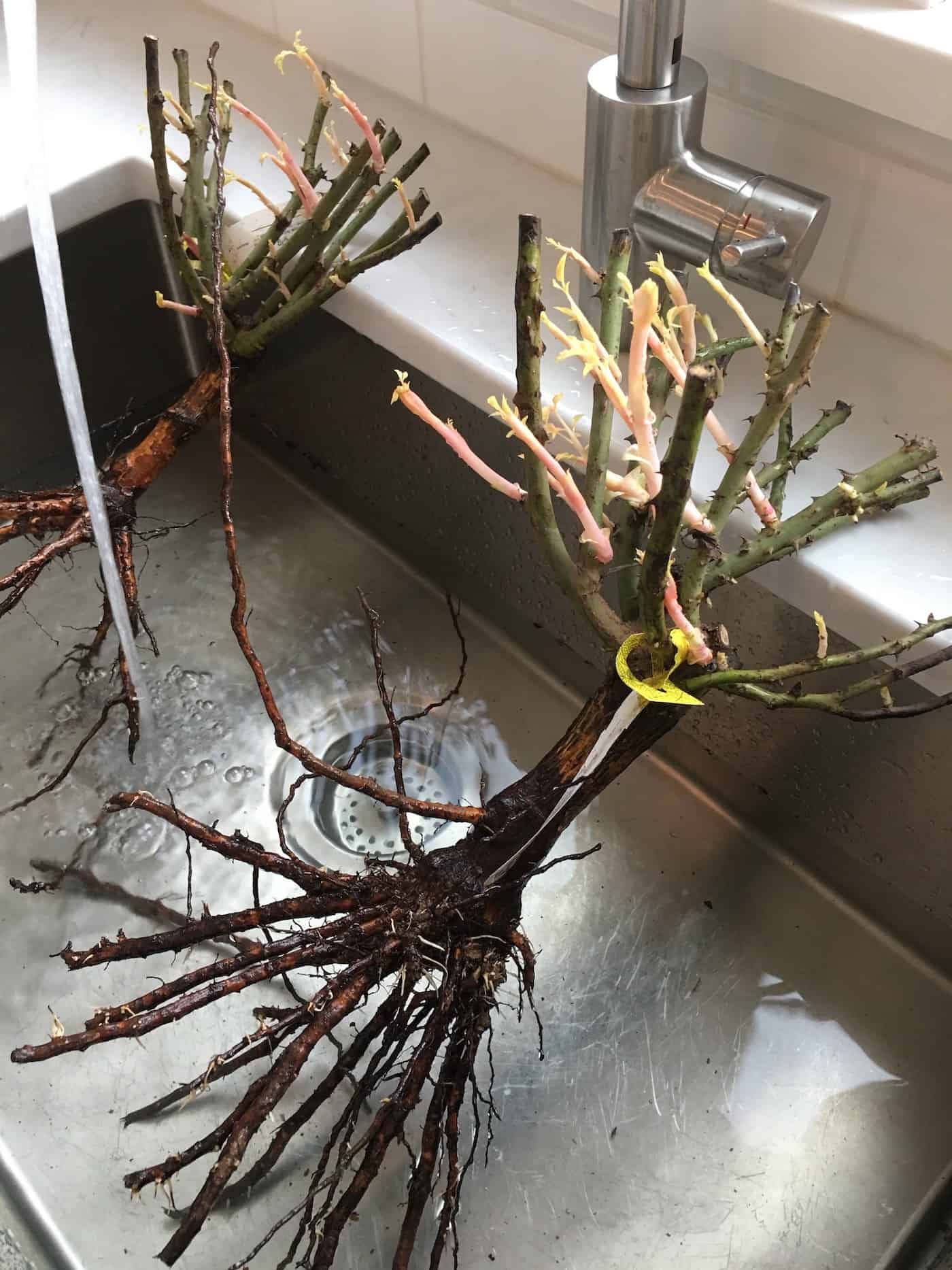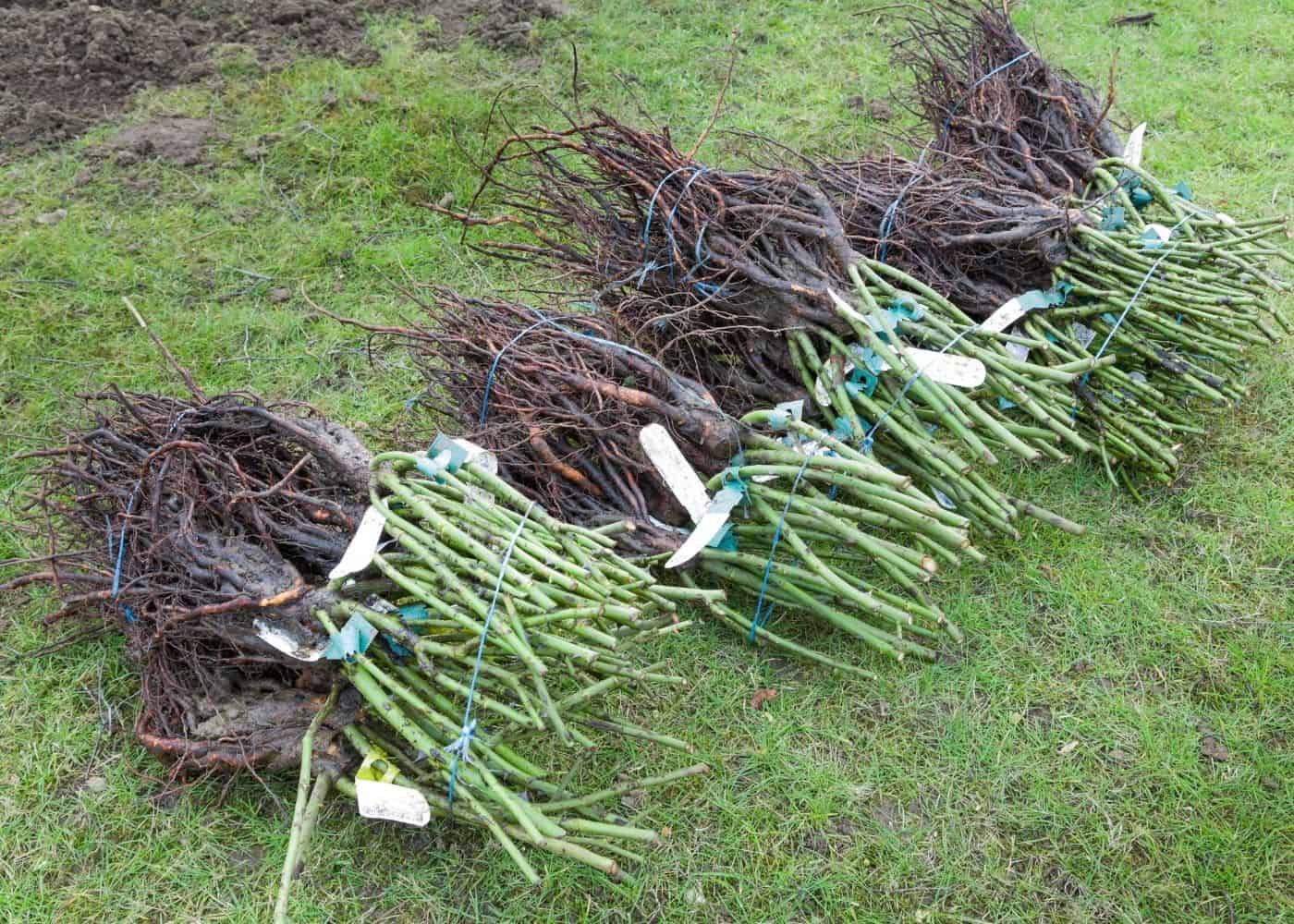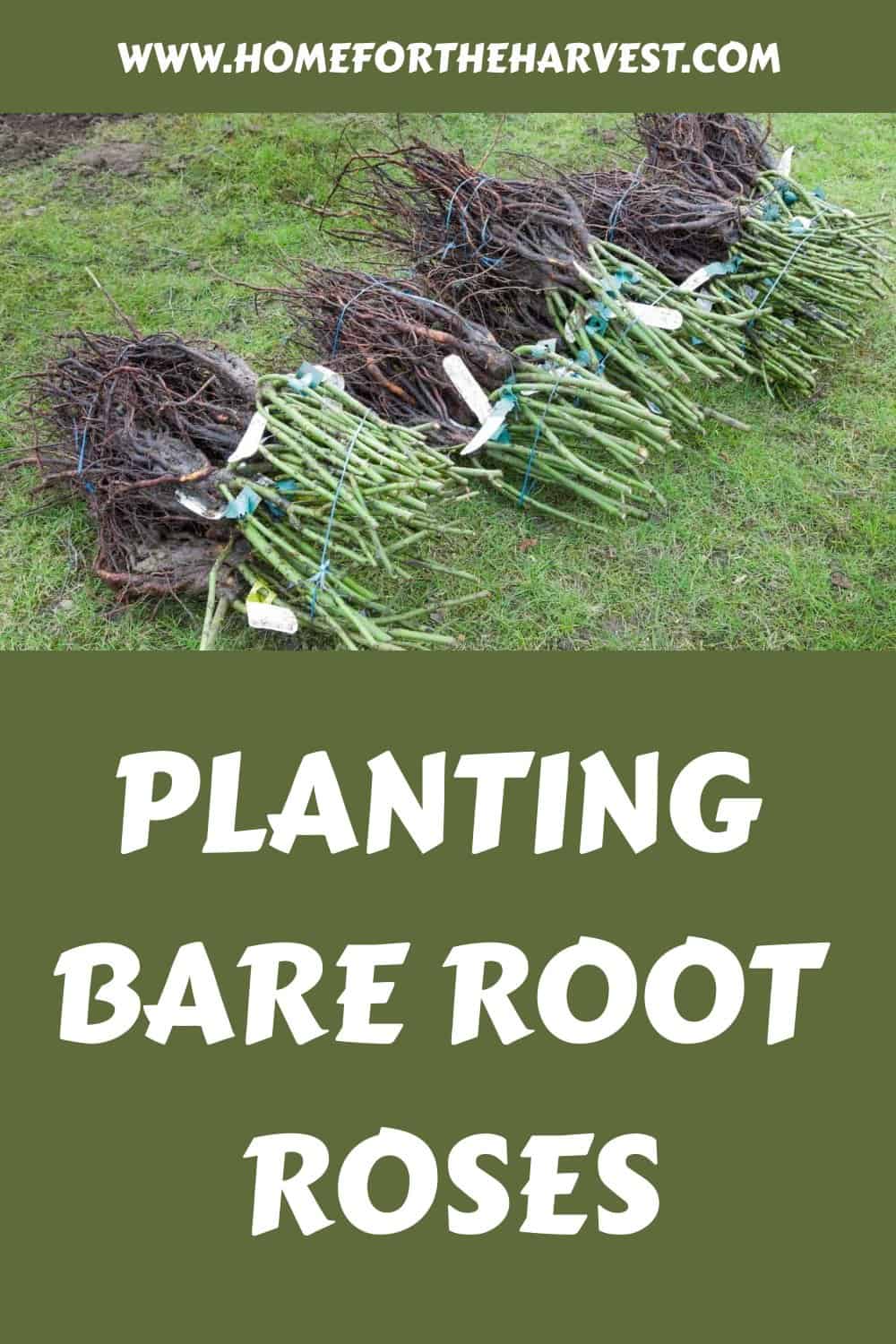Bare-root roses should be planted in early spring as soon as they arrive. If immediate planting is delayed, the moist, dormant plants can be stored in a sealed bag for 2-3 weeks in a cold location before planting.
Dig a planting hole at least as deep and wide as the roots, generally at least 12″ wide and 12″-18″ deep. Hold the plant at about 2″ below soil level by the bud union or knot at the base of the canes. Backfill carefully with soil enriched with organic compost and water thoroughly after planting.

Planting basics for bare-root roses
Bare-root roses can look intimidating to plant when they arrive at your doorstep. Fortunately, these spindly-looking plants are usually incredibly hardy and quickly become established in the landscape after planting. With a little care, you can have healthy and beautiful roses blooming in your garden within months.
Bare root roses are rose plants that have been propagated at a plant nursery and then dug up so all the roots are visible (rather than potted up into planter pots). The bare-root rose plants are then kept dormant in refrigerated storage at temperatures just above freezing. Bare root roses are then shipped to gardeners at an appropriate time for planting (usually March to April in most climates).
Bare root roses are generally shipped in early spring, which is an excellent time for planting roses. Early spring is near the end of their wintertime dormancy. During this period, it’s important that the plants stay cold and moist (as they would be in an outdoor environment in the soil). Open the delivery box and check the state of the roses as soon as they arrive to ensure the roots are still damp after shipping.
When it comes to planting bare-root roses, there are a few key tips to keep in mind. One of the most important is to plant them as soon as possible – ideally within a couple of days of receiving them. Another is to pay special attention to keeping the plants moist, as bare-root roses do not have the fine feeder roots required to absorb optimal amounts of water. You may also wish to trim off any damaged roots and/or damaged canes from the plant before planting.

How to store bare-root roses before planting
If you need to delay planting your bare-root roses for any reason, make sure to store the plants in a cool, moist location (such as a refrigerator) in a sealed bag. You can also soak the roots in clean water for up to 1-2 days prior to planting. The roots should be kept damp during this storage period and protected from heat and/or air circulation. If planting is delayed for more than a week or two, plant the bare root rose in a 5-10 gallon pot temporarily.

How to plant bare-root roses
To plant your bare-root roses, begin by digging a hole at least as deep and wide as the roots. Place the roots of the plant down into the hole. The hole should allow for the roots to fan out nicely without them curling back on themselves. When planting, hold the plant by the bud union or knot at the base of the canes (the point at the top of the roots where all the canes come out).
Position the union/knot (where the stems/canes meet the roots) at an elevation about 2 inches below soil level. Gardeners in very wet climates may want to position the union/knot at surface level, while those in very cold climates may wish to place the union/knot 3-4 inches below the soil line. Gardeners in warm areas with no freezing weather can place the bud union at or even up to 2″ above the soil level. Some gardeners like to build a little pointed mound at the bottom of the hole to rest the plant on, but you can also hold the plant in position.
In gardens with rich, well-drained soil, you can use the soil from the hole to backfill the plant. In less perfect soil conditions, it is common to mix some organic compost into the soil before planting (usually about 1/3 to 1/2 compost by volume). Be sure to tamp down the soil gently as you backfill and check that the bud union/knot level stays consistent.
Water the bare root rose thoroughly after planting. Top up the soil level if the soil has settled significantly down into the planting hole. Avoid fertilizing the bare-root rose at planting time.
Caring for bare-root roses after planting
Bare-root roses are generally mulched after planting. Add a layer of organic mulch on top of the soil around the plant to keep moisture in and regulate soil temperature. Good choices for organic mulch include homemade compost and arborist wood mulch.
Bare root roses also benefit from temporarily applying thick protective mulch around the exposed stems in the first few weeks after planting. Bare-root roses are prone to drying out as the plants do not yet have small white feeder roots established. To help the plant keep from drying out, mound mulch up around the base stems of the plant to about 6″ above ground level.
Water the newly-planted bare root rose frequently in the first few weeks after planting. This usually means at least 2-3 times per week, or at least twice as often as other plants in your yard require watering. The best way to water consistently is with drip irrigation or a soaker hose with an automated timer.
Assuming you’re planting in early spring, keep the protective mulch mound around the stems for 2-3 weeks. A good indication that the feeder roots have been established is when the plant starts to leaf out. Remove the mound from around the base of the plant when leaves first emerge and rake the mulch out flat with the surface around the plant.
Fertilizer can be applied to the planted bare-root rose after it grows leaves. In nutrient-deficient soils, apply a slow-release organic fertilizer formulated for root growth (typically low nitrogen (N) and high P in the NPK).
Continue watering the plant frequently for the first year after planting. In most climates, this translates to watering once or twice per week and perhaps more if conditions are overly hot and dry. This is to keep the plant blooming and reduce the chance of the leaves yellowing. Watering frequency can be decreased in subsequent years once the root system is well established in the surrounding soil.
Do not prune your bare root rose the year it was planted. Wait to prune newly planted roses until after their second growing season in the ground.






